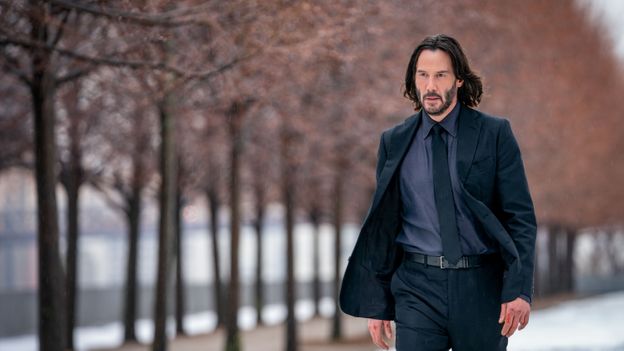
With the first John Wick (2014), Keanu Reeves and director Chad Stahelski established a franchise that soars above most action films. Merging an artful aesthetic with brilliantly choreographed and shot fight scenes, it set a standard matched in its three sequels, including the latest, John Wick: Chapter 4. Knives, guns, swords and martial arts come into play, often in lovely, red-tinged light to the sound of glass shattering all around. The violence is just cartoonish enough not to be truly disturbing, at least most of the time.
More like this:
– A B-movie about a drug-crazed bear
– Why the Oscars were ‘a slap in the face for Hollywood’
– The greatest monster film ever made
There is another reason the films are so entertaining and successful, though (with the franchise earning more than $500 million dollars so far). Perversely, we love John Wick himself. That lethal, bereaved assassin is a good bad guy for our times, the natural extension of Tony Soprano, Walter White and all the other heroic antiheroes the culture has embraced. A hit-man who tried to escape the criminal life, Wick returns with fury and vengeance after his wife dies and thugs kill the dog she left him. He only murders villains and is driven by humanising grief. Reeves’ action moves and his sincerity, even when Wick is at his most stern, perfectly capture the blend of emotion and kinetic energy that define the films.
The twist in Chapter 4 is that John Wick goes full James Bond, globe-trotting and shooting his way through glamorous cities, with action that is even more spectacularly staged. Running at 2 hours and 49 minutes, it is bigger than the previous films in every way – not better or worse, just more.
The plot picks up where the last film left off. The High Table, the organisation that controls crime around the world, has a multi-million-dollar contract out on Wick, who killed a High Table member. In more familiar Mafia terms, it’s as if he murdered a made man. And he violated another rule by doing it on the grounds of a Continental hotel, the supposed safe spaces for assassins around the world. Like Michael Corleone in The Godfather Part III, Wick keeps getting pulled back in. Now, to try to free himself once more, he must grapple with a new villain, the Marquis de Gramont (Bill Skarsgård), who in his first scene commits a murder so arbitrary and upsetting that he instantly becomes one of the franchise’s most despicable figures.
As Wick fights his way along, he meets colourful allies and enemies. Donnie Yen (the Ip Man films) plays a blind assassin. Ian McShane returns as Winston, the ever-logical and calm manager of the New York Continental, the only person able to ask John, “Have you learned nothing?” As always, McShane’s urbane, dry delivery makes the films even more engaging.
In Osaka, the big action scenes take place with arrows as well as swords, amid glass display cases holding samurai costumes, a classic Wick setting. In Berlin, Wick battles Killa (Scott Adkins), a corpulent, gold-toothed villain who, oddly for a Wick film, seems like a misconceived reject from Goldfinger. But in the extravagant fight scene, Wick chases him through a dance club, where waterfalls line the walls and techno music drowns out the sounds of gunshots and axes to the head. Throughout, Wick is trailed by The Tracker (Shamier Anderson), a bounty hunter with a very well-trained killer dog (in fact five incredible stunt dogs).
John Wick: Chapter 4
Director: Chad Stahelski
Cast: Keanu Reeves, Donnie Yen, Bill Skarsgård
Run-time: 2hr 49m
Release date: 24 March in the US and UK
And in Paris, Wick has a meeting with the Marquis, the Eiffel Tower providing a picturesque backdrop. A big, climactic scene is set on the steps and in the shadow of Sacré-Coeur. The backdrops make the criminal underworld look like the subject of a glossy fashion-magazine photo shoot. There is nothing wrong with that, but it is a sign of a slender plot engineered to suit the settings.
The film echoes a central question from all the Wick films, though: is he a natural-born murderer? Or a good man underneath it all? “This is who you are,” the Marquis tells him. “A killer.” The question is pointedly unresolved here. Beneath the supersized action, the character hasn’t deepened over time. For an action series, that isn’t a flaw, but it is a missed opportunity.
The franchise is already growing in new directions. The Continental, a three-episode spin-off series coming this year on Peacock, is set in the 1970s and tells the origin story of Winston and his hotel. Production has finished on Ballerina, set between Wick 3 and 4, starring Ana de Armas as a dancing assassin. We don’t know if she kills , but we do know Reeves is in the film. Apparently, as long as the franchise keeps making money, one way or another John Wick will never die.
★★★★☆